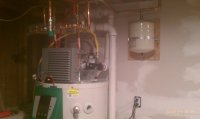cloves
Member
Hi everyone,
I recently installed a new water heater (vertex 50 gallon), expansion tank (2 gall), ge water filter (whole house with built in check valve), and 2 pressure gauges. Pressure gauge 1 is directly after the city water main and reads 60 PSI. Pressure gauge 2 is placed after my water filter.
Now the expansion tank is placed on the cold water supply line right before entering the water heater. Before putting the water on, I filled the expansion tank to 59 PSI. Then I filled the system with water.
Here is my question and problem. I have noticed that the water pressure gauge (the one after the water filter) has been rising all the way upto 70 PSI (after a full day of the water not being used). The city gauge maintains 60 psi. Is this normal? Or do I have to put more air into the expansion tank?
I recently installed a new water heater (vertex 50 gallon), expansion tank (2 gall), ge water filter (whole house with built in check valve), and 2 pressure gauges. Pressure gauge 1 is directly after the city water main and reads 60 PSI. Pressure gauge 2 is placed after my water filter.
Now the expansion tank is placed on the cold water supply line right before entering the water heater. Before putting the water on, I filled the expansion tank to 59 PSI. Then I filled the system with water.
Here is my question and problem. I have noticed that the water pressure gauge (the one after the water filter) has been rising all the way upto 70 PSI (after a full day of the water not being used). The city gauge maintains 60 psi. Is this normal? Or do I have to put more air into the expansion tank?

